Contents
- China doubles down on claims on Bhutan boundary
- India, Afghanistan ink 5 agreements
- Kuwait’s bill on workers
- Detecting RNA virus using Raman spectroscopy
- A sponge-like single-cell ancestor
- Suspected case of bubonic plague found: Inner Mongolia
- Replace multi-modal transportation of goods act
- India may see trade surplus after 18 yrs
CHINA DOUBLES DOWN ON CLAIMS ON BHUTAN BOUNDARY
Focus: GS-II International Relations
Why in news?
Days after Bhutan sent China a demarche protesting Chinese claims to the Sakteng wildlife sanctuary in Eastern Bhutan, Beijing has included Bhutan’s “Eastern sectors” to the boundary dispute between the two countries for the first time.
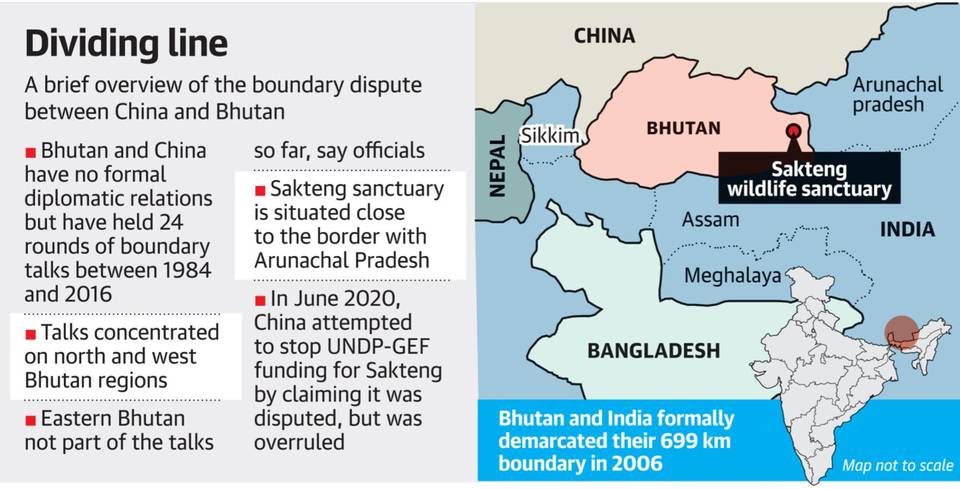
Background to the situation
- According to written records, there has been no mention of Eastern Bhutan, or Trashigang Dzongkhag (district), where Sakteng is based, that borders Arunachal Pradesh, in 24 previous rounds of boundary negotiations held between the two countries between 1984 and 2016.
- The negotiations have not been held since the Doklam standoff between Indian and Chinese troops in 2017.
- Bhutan has always maintained a discreet silence on its boundary negotiations with China, and it does not have any formal diplomatic relations with Beijing.
China targets India’s Arunachal Pradesh?
- The key could be the proximity of Bhutan’s “eastern sector” to Arunachal Pradesh – which China claims in its entirety as part of “south Tibet” : It could be the primary reason for Beijing to talk about differing boundary perceptions with Bhutan now.
- Though China might not have said it publicly, it’s not surprising if Beijing was opposed to the India-Bhutan boundary delimitation agreement, which was signed in 2006.
- China’s state-controlled media and Chinese academics consistently blame India for Beijing-Thimphu not having diplomatic ties.
Recently in News: Click Here to read more about Sakteng Wildlife Sanctuary (SWS), India – Bhutan relations and more
-Source: The Hindu, Hindustan Times
INDIA, AFGHANISTAN INK 5 AGREEMENTS
Focus: GS-II International Relations
Why in news?
India and Afghanistan signed five agreements for developing educational infrastructure in four Afghan provinces, with the move seen as a reiteration of New Delhi’s support to Kabul at a time when the war-torn country’s peace process is confronting challenges.
Details
- The five memorandums of understanding (MoUs) were signed under the high impact community development projects (HICDP) programme being implemented by India to further strengthen the bilateral development partnership.
- Since 2001, India has undertaken projects worth $3 billion in Afghanistan.
- These projects are part of India’s commitment to assisting Afghanistan emerge as a “peaceful, united, prosperous and pluralistic nation”.
- Despite an agreement signed by the US and the Taliban in February, Afghanistan has witnessed a surge in terrorist violence even as it grapples with the impact of the Covid-19 pandemic.
Afghanistan–India relations
- Bilateral relations between Afghanistan and India have remained strong and friendly over the decades, tracing back to the Indus Valley Civilisation.
- Between the 10th century to the mid-18th century, northern India has been invaded by a number of invaders based in what today is Afghanistan. Among them were the Ghaznavids, Ghurids, Khaljis, Suris, Mughals and Durranis.
- The Republic of India was the only South Asian country to recognize the Soviet-backed Democratic Republic of Afghanistan in the 1980s.
- India-Afghanistan relations were diminished during the 1990s Afghan civil war and the Taliban government.
- India aided the overthrow of the Taliban and became the largest regional provider of humanitarian and reconstruction aid to the present day Islamic Republic of Afghanistan.
- India shares border with Pakistan and there is the Durand Line conflict between Pakistan and Afghanistan.
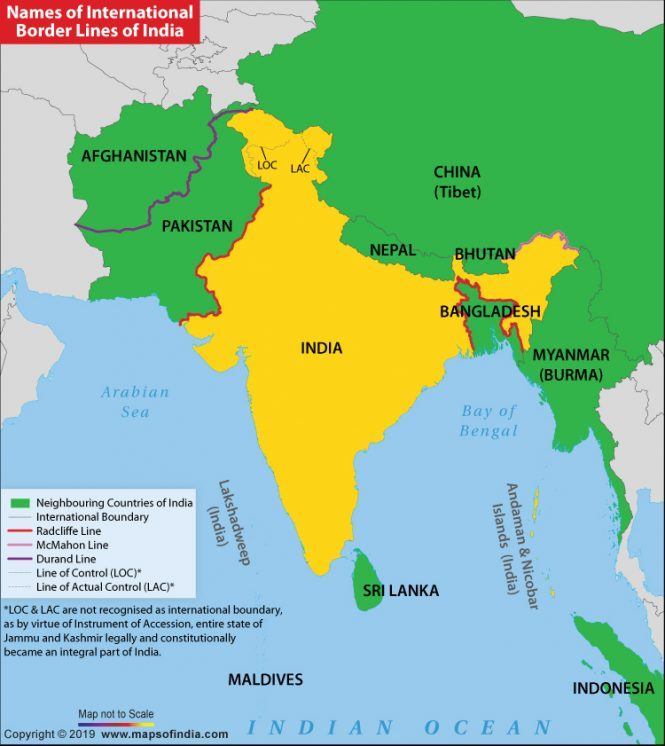
India’s Interest in Afghanistan
- Economic and Strategic Interest: Afghanistan is a gateway to the oil and mineral-rich Central Asian republics.
- Afghanistan’s main advantage is its geography, as anyone who is in power in Afghanistan controls the land routes connecting India with Central Asia (via Afghanistan).
- Developmental Projects: The massive reconstruction plans for the country to offer a lot of opportunities for Indian companies.
- Three major projects: the Afghan Parliament, the Zaranj-Delaram Highway, and the Afghanistan-India Friendship Dam (Salma Dam), along with India’s assistance of more than $3 billion in projects, hundreds of small development projects (of schools, hospitals and water projects) have cemented India’s position in Afghanistan.
- Security Interest: India has been the victim of state-sponsored terrorism emanating from Pakistan supported terrorist group operating in the region (e,g. Haqqani network).
-Source: Hindustan Times
KUWAIT’S BILL ON WORKERS
Focus: GS-II International Relations
Why in news?
A draft bill to reduce the number of foreign workers in Kuwait has been deemed constitutional by the legal and legislative committee of the Gulf state’s national assembly.
Details
- Kuwait is planning out a more comprehensive plan to cut down on foreign workers, and this has led to fears in India that as many as 7-8 lakh Indians could be forced out of Kuwait if the bill is enacted into law.
- The bill proposes that the number of Indians, who form the largest expatriate community in Kuwait, be reduced to 15% of the country’s 4.8 million population.
- The bill, however, proposes similar quotas for other nationalities too.
- With its own citizens turning into a minority, Kuwait has been working to reduce its dependence on foreign workers.
India–Kuwait relations
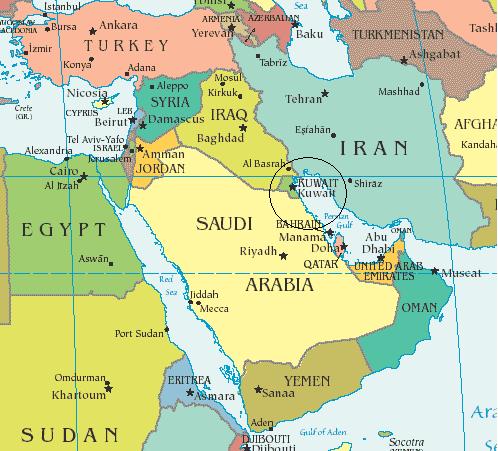
- India–Kuwait relations are bilateral diplomatic relations between the Republic of India and the State of Kuwait.
- Kuwait is the source for 10-12% of India’s oil imports while India is among the largest trade partners of Kuwait.
- Indians form one of the largest expatriate communities in Kuwait with their presence in white collar jobs increasing consistently.
- Indians have been described by the Emir’s special envoy as having acquired a special space in Kuwait as “a brilliant and the least problematic expatriate community which works for the overall development of Kuwait”.
-Source: Times of India
DETECTING RNA VIRUS USING RAMAN SPECTROSCOPY
Focus: GS-III Science and Technology
Why in news?
- Researchers have turned to Raman Spectroscopy to detect RNA viruses present in saliva samples.
- It is a study to analyse non-infectious RNA viruses using conventional Raman Spectroscopy without using any additional reagent to enhance the signal.
Significance of the Study
- It has been reported that novel coronavirus is found in sufficient numbers in human saliva. For the study, the researchers spiked saliva samples with non-infectious RNA viruses and analysed it with Raman Spectroscopy.
- They analysed the raw Raman Spectroscopy data and compared the signals with both viral positive and negative samples.
- This conceptual framework to detect RNA viruses in saliva could form the basis for field application of Raman Spectroscopy in managing viral outbreaks, such as the ongoing COVID-19 pandemic.
- Since the tool can only identify RNA viruses and not identify the specific one, it can be used only for screening.
What is Raman Spectroscopy?
- Raman Spectroscopy is a non-destructive chemical analysis technique which provides detailed information about chemical structure, phase and polymorphy, crystallinity and molecular interactions.
- It is based upon the interaction of light with the chemical bonds within a material.
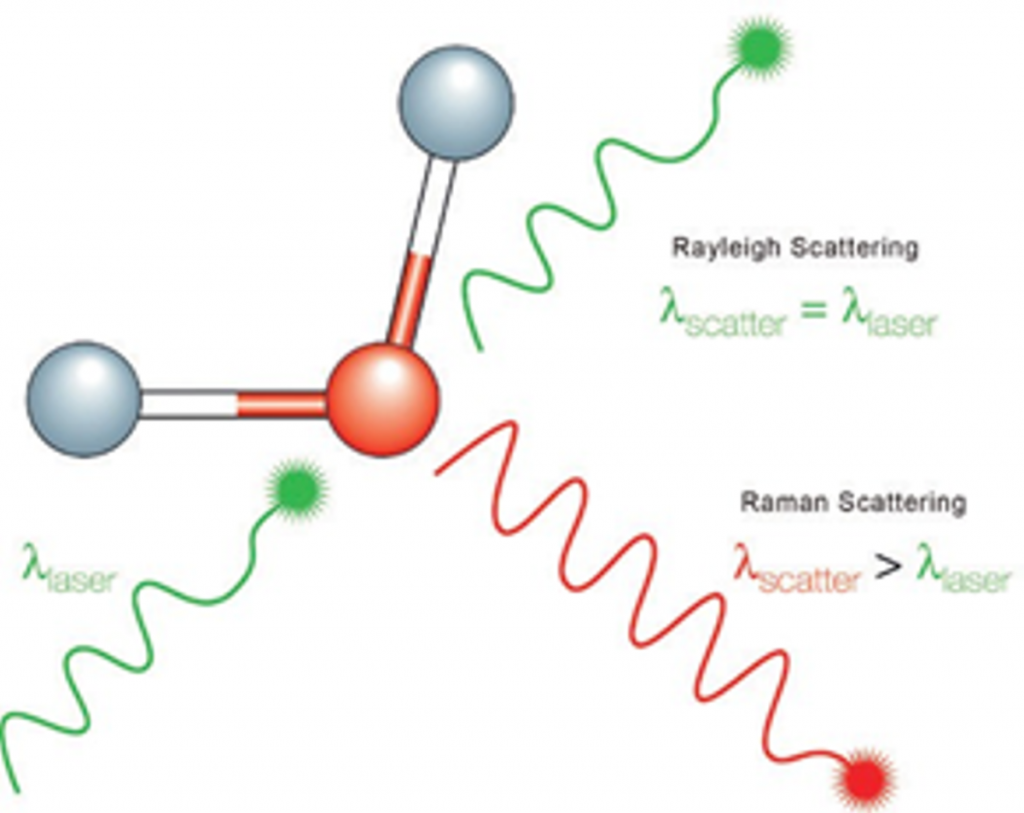
What is Raman Effect?
- Raman Effect is a phenomenon in spectroscopy discovered by the eminent physicist Sir Chandrasekhara Venkata Raman in 1928.
- After two years in 1930, he got Nobel Prize for this remarkable discovery and this was the first Nobel Prize for India in the field of Science.
- Raman Effect is a change in the wavelength of light that occurs when a light beam is deflected by molecules.
- When a beam of light traverses a dust-free, transparent sample of a chemical compound, a small fraction of the light emerges in directions other than that of the incident (incoming) beam.
- Most of this scattered light is of unchanged wavelength.
- A small part, however, has wavelengths different from that of the incident light; its presence is a result of the Raman Effect.
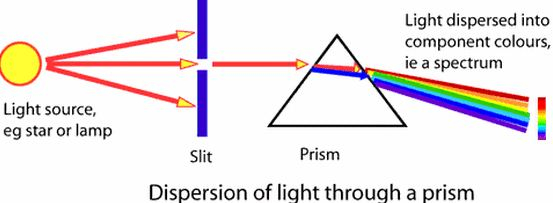
Prelims Bit: February 28th: National Science Day
28th February is celebrated as National Science Day (NSD) in India. NSD is celebrated to commemorate discovery of the ‘Raman Effect’, which led to Sir C.V. Raman winning the Noble Prize.
-Source: The Hindu
A SPONGE-LIKE SINGLE-CELL ANCESTOR
Focus: GS-III Science and Technology
Introduction
- The Smithsonian Institution points out that an environment devoid of oxygen, and high in methane, was not fit for animal life, though it could ‘host’ microorganisms which could cope with the incoming sunlight and use it to generate energy for living.
- This was around 3.4 billion years (Byr)ago, about 1 Byr after the Earth itself was born. In the process, these microorganisms generated the gaseous waste product called oxygen.
- About 2 Byr later, thanks to this ‘great oxidation event’, the amount of oxygen on Earth became an important component of the Earths’ surface, and amenable for animal life.
Mistranslation of DNA
- Choanoflagellates are the closest living relatives of animals that appeared nearly a billion years ago.
- Thanks to recent genome sequencing efforts, they have been shown to possess some key processes, such as cell signalling, cell–cell adhesion, that were thought to be present only in multicellular animals.
- Over time, animal cells also evolved to produce increased amounts of molecules called reactive oxygen species (ROS), which are involved in many essential cell activities but toxic at high levels.
- In addition, more complexity necessitates a substantial increase in the genome size of the animal with concomitant increase in all transactions in the cell: DNA, the genetic material in the cells of the various organs, their transcription of the information to messenger RNA (mRNAs), then translation of these into the amino acid sequences that make individual proteins in the cells through what are called tRNAs — at least one per amino acid.
- If a wrong interpretation of the genetic code at the protein level occurs, it will lead to functional disorders and even diseases.
Great Oxidation Event
- Great Oxidation Event refers to a series of chemical changes that geologists and geochemists have observed in rocks that are between 2.5 and 2.3 billion years old.
- These changes were the result of oxygen given off by ancient cyanobacteria (blue-green algae). Communities of this bacteria lived in shallow seawater and were preserved in rocks as structures called stromatolites.
- Stromatolite means ‘layered rock’. It is a rocky structure created by the activity of colonies of single-celled bacteria, mostly cyanobacteria.
- Oxygen first accumulated in Earth’s atmosphere at this time and has been present ever since.
-Source: The Hindu
SUSPECTED CASE OF BUBONIC PLAGUE FOUND: INNER MONGOLIA
Focus: GS-III Science and Technology
Why in news?
China’s health authorities are on high alert after a suspected case of the infectious bubonic plague was reported from Inner Mongolia.
Local authorities in Bayannur issued a third-level warning for plague prevention and control that will last till the end of 2020.
Plagues
Plague is an infectious disease caused by the bacterium Yersinia pestis.
There are three types of plagues:
- septicemic, which spreads in the blood;
- bubonic, which affects the lymph nodes; and
- pneumonic, which affects the lungs.
Bubonic and septicemic plague are generally spread by flea bites or handling an infected animal.
The pneumonic form is generally spread between people through the air via infectious droplets.
Bubonic plague
- Bubonic plague is one of three types of plague, and one to seven days after exposure to the bacteria, flu-like symptoms develop.
- Swollen and painful lymph nodes occur in the area closest to where the bacteria entered the skin.
- In the bubonic form of plague, the bacteria enter through the skin through a flea bite and travel via the lymphatic vessels to a lymph node, causing it to swell.
- Vaccines have not been found to be very useful for plague prevention.
- Prevention is through public health measures such as not handling dead animals in areas where plague is common.
- The plague was the cause of the Black Death that swept through Asia, Europe, and Africa in the 14th century and killed an estimated 50 million people.
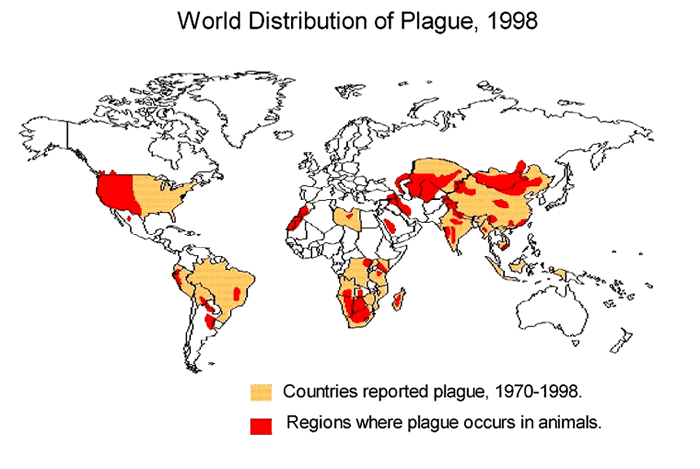
-Source: Hindustan Times
REPLACE MULTI-MODAL TRANSPORTATION OF GOODS ACT
Focus: GS-III Industry and Infrastructure
Why in news?
- The Commerce Ministry is considering replacing the Multi-Modal Transportation of Goods Act (MMTG) with a full-fledged national logistics law with a view to promote growth of the sector.
- National Logistics Efficiency and Advancement Predictability and Safety Act (NLEAPS) is under consideration and this law tends to define various participants of the logistics space and create a light regulatory ecosystem.
Highlights
- Multimodal transportation refers to a combination of more than one mode of movement, such as rail, road or sea, for end-to-end delivery of goods.
- The move assumes significance as high logistics cost impacts the competitiveness of domestic goods in the international market.
- Effective implementation of the policy would help provide an impetus to trade, enhance export competitiveness, and improve India’s ranking in the Logistics Performance Index.
- India’s logistics sector is highly fragmented and the government aims to reduce the logistics cost from the present 14% of the Gross Domestic Product to less than 10%.
Logistics Performance Index (LPI)
The Logistics Performance Index (LPI) is an interactive benchmarking tool created by the World Bank to help countries identify the challenges and opportunities they face in their performance on trade logistics and what they can do to improve their performance.
It is the weighted average of the country scores on six key dimensions:
- Efficiency of the clearance process by border control agencies, including Customs.
- Quality of trade and transport related infrastructure.
- Ease of arranging competitively priced shipments.
- Competence and quality of logistics services.
- Ability to track and trace consignments.
- Timeliness of shipments in reaching destination.
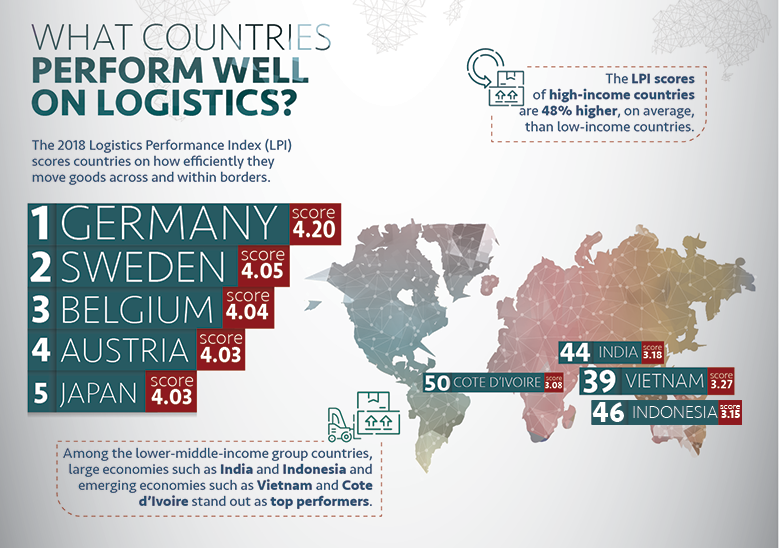
This measure indicates the relative ease and efficiency with which products can be moved into and inside a country. Germany and Singapore are the most efficient and highest ranked LPI countries.
-Source: The Hindu
INDIA MAY SEE TRADE SURPLUS AFTER 18 YRS
Focus: GS-III Indian Economy
Why in news?
India may register its first monthly trade surplus in over 18 years as the pace of contraction of exports is estimated to have slowed down to around 12%, while imports are seen to have fallen almost 49% during the month.
Details
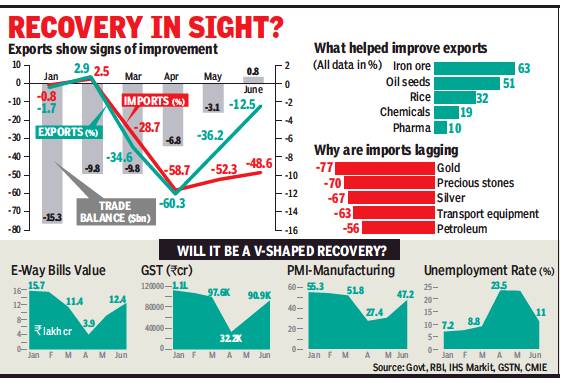
- The last time India had a positive balance on the trade account was in January 2002 when it had a surplus of $10 million with exports of $4.3 billion.
- But imports remain an area of concern, as it is a barometer of overall economic activity.
- The initial numbers suggest that the sharp decline in imports was led by gold, silver and precious & semiprecious stones, which are also linked to exports.
- During crises, demand for jewellery drops significantly as people look to conserve cash.
- Imports related to the textiles sector — including cotton, fabric and made-ups — are also down sharply along with transport equipment, chemicals, iron & steel, machine tools and electronics, indicating a slump in economic activity.
-Source: Times of India





